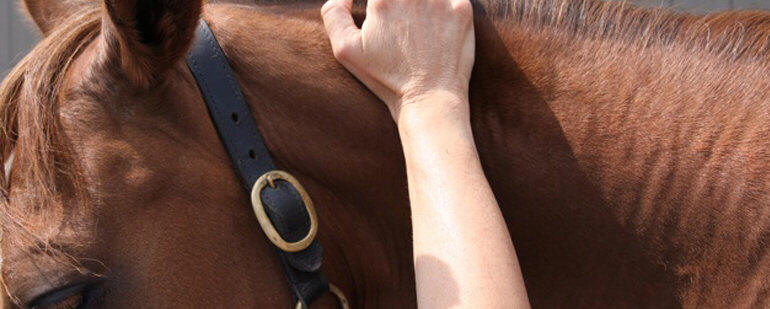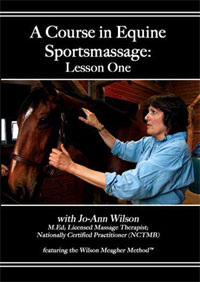|
 Welcome! Welcome!
This newsletter is all about how to help you
help your horse, move better, last longer and prevent injury.
Enjoy

GOOD MOTION IS INTUITIVE
 Once
you have to think about motion, you have interrupted the motion. Here
is an example. I was finished working on horses at a barn on a warm
spring afternoon, when Mrs. Honey, the owner of the farm called out
to me. She came out of her house with golf clubs, a bucket of golf balls,
and a big smile, as she asked if I wanted to drive some balls. I told
her I did not play golf, but I did take a few lessons as an undergraduate
in college many years ago. ”Oh, come on, give it a try she said. All
you have to do, is hit the ball as far as you can across that big lawn
over there”. Well, nothing ventured, nothing gained I thought. I took
the club and drove the ball nearly 100 yards across the lawn and more.
She couldn’t believe how high and far I drove that ball. She said” I
thought you told me you didn’t play golf?” “ I don’t,” I replied. Much
to her surprise and delight, I presented her with a challenge and some
competition. Mrs. Honey took quite a swing, and with great precision,
and execution, she drove the ball just short of mine. Once
you have to think about motion, you have interrupted the motion. Here
is an example. I was finished working on horses at a barn on a warm
spring afternoon, when Mrs. Honey, the owner of the farm called out
to me. She came out of her house with golf clubs, a bucket of golf balls,
and a big smile, as she asked if I wanted to drive some balls. I told
her I did not play golf, but I did take a few lessons as an undergraduate
in college many years ago. ”Oh, come on, give it a try she said. All
you have to do, is hit the ball as far as you can across that big lawn
over there”. Well, nothing ventured, nothing gained I thought. I took
the club and drove the ball nearly 100 yards across the lawn and more.
She couldn’t believe how high and far I drove that ball. She said” I
thought you told me you didn’t play golf?” “ I don’t,” I replied. Much
to her surprise and delight, I presented her with a challenge and some
competition. Mrs. Honey took quite a swing, and with great precision,
and execution, she drove the ball just short of mine.
 She
told me it was my turn next. Hesitantly, knowing my little experience
as a golfer, I decided to think about how to hit the ball so I could
repeat my previous performance. I stood square, hips directly below
my shoulders, arms extended with slight flex of the elbow, knees bent,
waist slightly flexed. I swung at the ball, and it landed about 10 feet
from me and in to the ground. Wow, I thought that was pathetic. Mrs.
Honey laughed and told me to try again. This time, I really concentrated,
got in to my position and, whamo, the ball went 15 feet while the club
jammed in to the ground and tore up the grass. What was I doing wrong? She
told me it was my turn next. Hesitantly, knowing my little experience
as a golfer, I decided to think about how to hit the ball so I could
repeat my previous performance. I stood square, hips directly below
my shoulders, arms extended with slight flex of the elbow, knees bent,
waist slightly flexed. I swung at the ball, and it landed about 10 feet
from me and in to the ground. Wow, I thought that was pathetic. Mrs.
Honey laughed and told me to try again. This time, I really concentrated,
got in to my position and, whamo, the ball went 15 feet while the club
jammed in to the ground and tore up the grass. What was I doing wrong?
Read
further for an example of good motion with an Olympic Equestrian Gold
Medalist 

CASE STUDY:
Shortened stride from hind leg; Less push from hind leg.
A top rider called me, voicing great concern
about his international competition horse because the horse was short
behind, and not stepping underneath his body with his right hind leg.
The horse’s push with the right hind was also diminished. The horse
was going to be shipping to compete in a qualifier for an international
competition in three weeks.
I understood the rider’s concern since a fraction
of an inch makes a difference in a competition. I told the rider that
if the origin of the problem was coming from a tight muscle, I could
likely restore the range of motion to the horse’s hind leg with one
or two treatments. (I believe if it is the correct treatment, results
should be reached within one to two treatments. If results do not occur
in two treatments, then it is not the correct treatment!).
Problem Solving:
 Since
all muscles pull, and that is all they do in terms of motion, I needed
to think in terms of the biomechanics to begin to solve the shortened
stride problem. It is the release process of the muscle that is effected
by simple muscle tightness. When muscles are tight, they do not release
easily for the opposite motion to occur. Thinking about which muscles
are not releasing is critical to solving the problem. A simple example
is a person who has tight back muscles. The back muscles are responsible
for extending the spine and keeping the person erect and standing upright.
If these same back muscles in a person are tight, they may not release
fully to allow for flexion of the spine, or bending forward... Since
all muscles pull, and that is all they do in terms of motion, I needed
to think in terms of the biomechanics to begin to solve the shortened
stride problem. It is the release process of the muscle that is effected
by simple muscle tightness. When muscles are tight, they do not release
easily for the opposite motion to occur. Thinking about which muscles
are not releasing is critical to solving the problem. A simple example
is a person who has tight back muscles. The back muscles are responsible
for extending the spine and keeping the person erect and standing upright.
If these same back muscles in a person are tight, they may not release
fully to allow for flexion of the spine, or bending forward...
Read more about the
problem, cause, and solution

|
|
|
|

TRAINER'S TIP


Sue Clarke has a wealth of knowledge and experience
as stable manager at Stonehall Farm, The Plains, Virginia, since 1992
(read more about Sue at the link below)
Question: What fundamental lesson do you
feel is very important for foals to learn that will remain with them
through their adult lives?
Read
Sue's answer


RIDER'S TIP

Quick Stress Reliever - Meditative
Breathing

Sometimes we forget to breathe. This simple
exercise can be used before competing, riding, social situations or
simply after a hard day at work. A very good, quick way to instantly
relieve stress is the following meditative breathing exercise:
1. Sit comfortably in a chair, or in the
car, if on the go. Feet flat on the ground, with arms and legs uncrossed.
Close eyes. Begin by breathing very slowly, deeply, noisily into your
belly.
2. First breath is in through your nose
and out your mouth. Pucker your lips and breath noisily on the out breath.
|
|


 Welcome!
Welcome! Once
you have to think about motion, you have interrupted the motion. Here
is an example. I was finished working on horses at a barn on a warm
spring afternoon, when Mrs. Honey, the owner of the farm called out
to me. She came out of her house with golf clubs, a bucket of golf balls,
and a big smile, as she asked if I wanted to drive some balls. I told
her I did not play golf, but I did take a few lessons as an undergraduate
in college many years ago. ”Oh, come on, give it a try she said. All
you have to do, is hit the ball as far as you can across that big lawn
over there”. Well, nothing ventured, nothing gained I thought. I took
the club and drove the ball nearly 100 yards across the lawn and more.
She couldn’t believe how high and far I drove that ball. She said” I
thought you told me you didn’t play golf?” “ I don’t,” I replied. Much
to her surprise and delight, I presented her with a challenge and some
competition. Mrs. Honey took quite a swing, and with great precision,
and execution, she drove the ball just short of mine.
Once
you have to think about motion, you have interrupted the motion. Here
is an example. I was finished working on horses at a barn on a warm
spring afternoon, when Mrs. Honey, the owner of the farm called out
to me. She came out of her house with golf clubs, a bucket of golf balls,
and a big smile, as she asked if I wanted to drive some balls. I told
her I did not play golf, but I did take a few lessons as an undergraduate
in college many years ago. ”Oh, come on, give it a try she said. All
you have to do, is hit the ball as far as you can across that big lawn
over there”. Well, nothing ventured, nothing gained I thought. I took
the club and drove the ball nearly 100 yards across the lawn and more.
She couldn’t believe how high and far I drove that ball. She said” I
thought you told me you didn’t play golf?” “ I don’t,” I replied. Much
to her surprise and delight, I presented her with a challenge and some
competition. Mrs. Honey took quite a swing, and with great precision,
and execution, she drove the ball just short of mine.  She
told me it was my turn next. Hesitantly, knowing my little experience
as a golfer, I decided to think about how to hit the ball so I could
repeat my previous performance. I stood square, hips directly below
my shoulders, arms extended with slight flex of the elbow, knees bent,
waist slightly flexed. I swung at the ball, and it landed about 10 feet
from me and in to the ground. Wow, I thought that was pathetic. Mrs.
Honey laughed and told me to try again. This time, I really concentrated,
got in to my position and, whamo, the ball went 15 feet while the club
jammed in to the ground and tore up the grass. What was I doing wrong?
She
told me it was my turn next. Hesitantly, knowing my little experience
as a golfer, I decided to think about how to hit the ball so I could
repeat my previous performance. I stood square, hips directly below
my shoulders, arms extended with slight flex of the elbow, knees bent,
waist slightly flexed. I swung at the ball, and it landed about 10 feet
from me and in to the ground. Wow, I thought that was pathetic. Mrs.
Honey laughed and told me to try again. This time, I really concentrated,
got in to my position and, whamo, the ball went 15 feet while the club
jammed in to the ground and tore up the grass. What was I doing wrong?
 Since
all muscles pull, and that is all they do in terms of motion, I needed
to think in terms of the biomechanics to begin to solve the shortened
stride problem. It is the release process of the muscle that is effected
by simple muscle tightness. When muscles are tight, they do not release
easily for the opposite motion to occur. Thinking about which muscles
are not releasing is critical to solving the problem. A simple example
is a person who has tight back muscles. The back muscles are responsible
for extending the spine and keeping the person erect and standing upright.
If these same back muscles in a person are tight, they may not release
fully to allow for flexion of the spine, or bending forward...
Since
all muscles pull, and that is all they do in terms of motion, I needed
to think in terms of the biomechanics to begin to solve the shortened
stride problem. It is the release process of the muscle that is effected
by simple muscle tightness. When muscles are tight, they do not release
easily for the opposite motion to occur. Thinking about which muscles
are not releasing is critical to solving the problem. A simple example
is a person who has tight back muscles. The back muscles are responsible
for extending the spine and keeping the person erect and standing upright.
If these same back muscles in a person are tight, they may not release
fully to allow for flexion of the spine, or bending forward...


 Over
the past year of 2011, Jo-Ann enjoyed teaching many professional massage
therapists, physical therapists, veterinarians, and some horse owners
the highly successful
Over
the past year of 2011, Jo-Ann enjoyed teaching many professional massage
therapists, physical therapists, veterinarians, and some horse owners
the highly successful